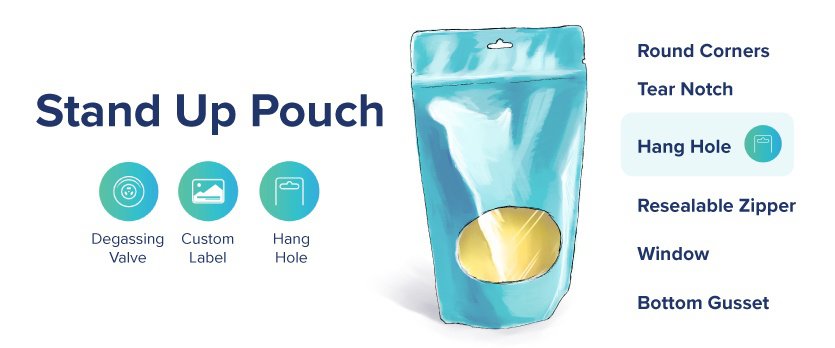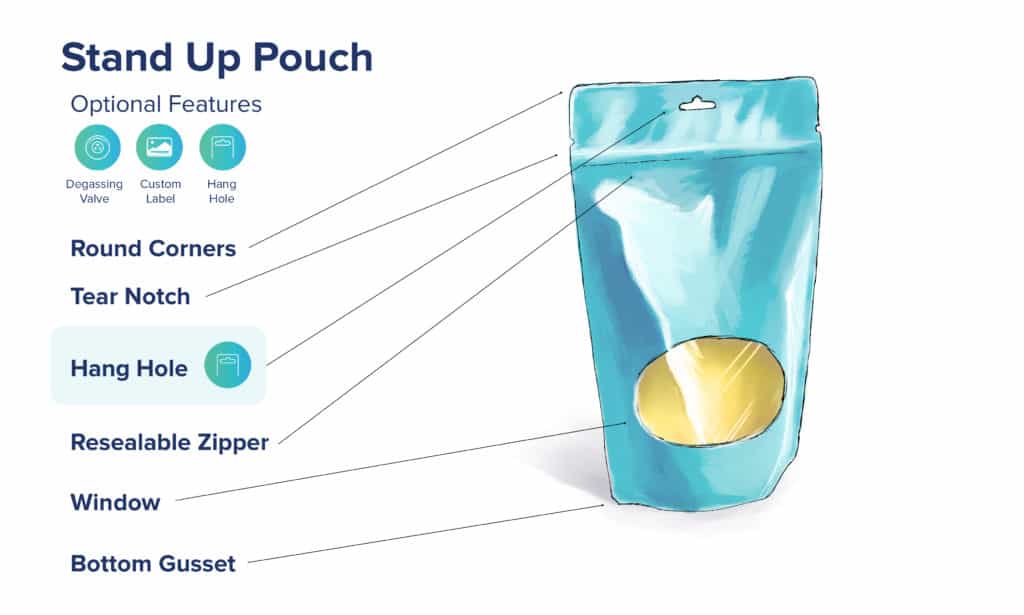Blog
Stand Up Pouch Anatomy
Anatomy of a Stand Up Pouch: 3 minutes read
Get out your notebooks – it’s time for a lesson in Standup Pouch anatomy!
Lesson Objectives
- To understand Stand-Up Pouch anatomy in relation to shelf-appeal and shelf-function.
- Understand how the construction of a Stand-Up Pouch supports the integrity and freshness of its contents.
- To understand the full potential of a Standup Pouch’s optional features.
Bottom Gusset
The Stand-Up Pouch gets its name from the bottom gusset. A bottom gusset is the part of the pouch that extends flat and allows it to stand up straight when the bag is full. When the pouch is empty, the gusset collapses to enable the pouch to lay flat and save space. This space-saving quality allows for significant savings in freight and storage space.
Tear Notch
Below where the bag seals, you will find a tear notch, which allows you to open the bag easily. An industrial bag sealer will help guard against contamination of your food or non-food items throughout storage or processing and delivering. In essence, the tear notch is a safety feature that helps ensure the pouch was not tampered before purchase.
Resealable Zipper
Once the tear notch is pulled, the tamper-safe seal breaks. Now oxygen and light are free to enter. Oxygen and light are the top enemies of food preservation. Customers value a product that maintains its freshness, which makes the Stand-Up Pouch’s resealable zipper a valuable and essential feature.
Rounded Edges
In the past, the majority of Stand-Up Pouches constructed had square corners. This sharp-corner design style led to accidental cuts and punctures – ouch! Thus, the evolution of rounded edges proved a smart solution that eliminated the risk potential when making use of the pouch. Safe for both your products and for the customer’s hands. Today, most Stand-up pouches manufacture with round corners. However, square-corners are an option for full-custom projects. Our team of flexible packaging experts would be happy to work with you to determine what’s the best choice for you.
Degassing Valve
A degassing valve is an optional feature most commonly used in flexible packaging for freshly roasted coffee. One-way degassing valves allow air and pressure to be released from within the bag while preventing air from getting in. Freshness and shelf-life extend by packaging coffee beans into a valved pouch immediately after roasting. Stand-Up Pouches come in non-valved or valved options. Your specific product type will determine if a valved bag is right for you.
Hang Hole
Certain pouches come with a pre-applied hang hole, but not all. A hang hole application is another optional feature to enhance the function of your packaging. Available in two styles: round hang hole, and the butterfly hang hole, also known as the sombrero hang hole. The addition of a hang hole is excellent for packaging on-the-go food items such as beef jerky, trail mixes, and other snack food products typically displayed at impulse aisles, on wall hooks, or other point-of-purchase locations. It is indeed valuable to have options for when shelf space is limited. Our hang hole application service is available for most stand up pouches. For more details, please visit our Hang Hole Application Services page.






